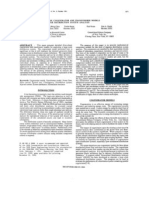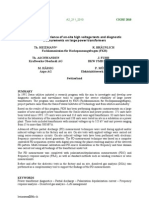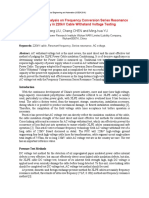HV Test
HV Test
Uploaded by
vjvijay88Copyright:
Available Formats
HV Test
HV Test
Uploaded by
vjvijay88Original Description:
Original Title
Copyright
Available Formats
Share this document
Did you find this document useful?
Is this content inappropriate?
Copyright:
Available Formats
HV Test
HV Test
Uploaded by
vjvijay88Copyright:
Available Formats
High Voltage Testing using Series Resonance with Variable Frequency
P. Mohaupt M. Gamlin R. Gleyvod J. Kraus G. Voigt
Reprint
ISH 97 Montreal
E 1-85
HIGH VOLTAGE TEST
High Voltage Testing using Series Resonance with Variable Frequency
P. Mohaupt M. Gamlin R. Gleyvod J. Kraus G. Voigt Haefely Trench AG Switzerland
1. Abstract For AC high voltage testing different kinds of equipment are known and available /1/. This paper describes the AC testing using the series resonance principle. The tuning of the resonant circuit with its changing test capacitances however is not achieved by varying the inductance /2/, but varying the frequency /3/. The described high voltage sources are available in a voltage range up to 800 kV, a current range up to 200 A and a frequency range from 30 Hz to 200 Hz. The advantage of variable frequency test systems compared to other AC test systems, such as transformers and resonant test systems with variable inductance, is their optimum testing power / weight ratio. This ratio results in reduced weight, dimensions, cost and price. Therefore this kind of AC test equipment is especially suited for on site testing of capacitive test objects like gas insulated busbars, cables and GIS substations.
2. Function principle The basic function principle as described in /2/ is shown in Fig. 1. In case of on site testing, for example after laying tests of high voltage cables, a power supply of some 100 kVA is required. Usually a power supply in this power range is not available at a substation. Therefore the test equipment has to be designed to be fed by a Dieselgenerator set. A pulse width modulated frequency converter is used to adjust frequency and output voltage of the test system. Special care has to be taken to assure the stability of the output frequency and voltage. The output signal of the frequency converter (FU) is shown in Fig. 2.
Fig. 1: The main components of a series resonant test system with variable frequency are a Diesel generator for power supply independent on mains supply if necessary (e.g. for on site use). The frequency converter for frequency and voltage adjustment, the filter set-up to enable PD measurement at PD levels down to less than 10 pC (not shown in the diagram), the exciter transformer for the excitation of the resonance circuit and the high voltage reactor for the high voltage generation.
Fig. 2: Typical output voltage of the frequency converter. The strongly non sinusoidal wave shape of the pulse width modulated frequency converter can be used for the excitation of the resonant circuit. However special care has to be taken to achieve PD levels in the range of less than 10 pC.
Fig. 3: Output voltage signal of the resonant test system. This is again a sine wave voltage with an amount of harmonics much less than 1 % (acc. to IEC 60 less than 5 % is required). This phenomenon results from using the series resonance principle. However (invisible in this scaling) this signal is still containing an amount of harmonics, which prevents PD measurement. To achieve PD levels of less than 10 pC, a special filter set-up is required to reduce the harmonics.
After passing a special filter set-up, to reduce the harmonics of frequency converter and to enable PD measurement the power is connected to the exciter transformer. From hereon the system operates as a conventional series resonant test system. Due to the physical behaviour of the series resonant circuit a sinusoidal output voltage is achieved as shown in Fig. 3.
3. PD Measurement Normally test equipment is designed to operate at background noise PD levels of less than 2 pC. In case of operating frequency converters close to test equipment, problems of an increase of the background noise level arise. In case of using a frequency converter for the power supply of the test equipment a background noise level of less than 2 pC seemed impossible. Therefore in the past the solutions were: performing no PD measurement or using the window technique on the PD detector. However using the window technique in this case leads to a signal reduction of that amount, that the PD measurement becomes doubtful, or at least not completely comparable. Therefore for this equipment a special filter set-up, together with a coreless, disc winding reactor design were used to achieve a harmonic attenuation of more than 100 dB.
4. General usage This kind of series resonant test system can be used in different areas of high voltage testing of test objects with capacitive behaviour. For example routine testing of switchgear units, high voltage cables, instrument transformers and others. The difference to conventional test equipment is the deviation of the testing frequency from the power frequency at a certain test capacitance. For some test objects a test frequency, differing from the power frequency is allowed by IEC. For others (after laying tests of high voltage cables) there are no standards at all. So testing at variable frequency in a range from 30 Hz up to 200 Hz, or at least up to 70 Hz is reasonable. The following examples show the typical usage of the variable frequency test equipment: Fig. 4 shows a SF6 insulated series resonant test system, which is used for routine testing on gas insulated switchgear units.
Fig. 4 Series resonant test system for routine testing of gas insulated switchgear units. Rated voltage 400 kV, PD level 2 pC, max. output current 0.8 A, frequency range 45 to 65 Hz. In this case the high voltage reactor is a gas insulated and coreless one, consisting of disk windings to enable further reduction of the harmonics for the PD measurement. No window technique is used for the PD measurement. The picture shows the complete test system without control unit.
Another usage is for the after laying test of high voltage power cables. Fig. 5 shows the set-up for a mobile test equipment. The total equipment, except the second reactor and the Diesel generator is placed on a 40 t trailer.
Fig. 5: Resonant test system with variable frequency. Rated data: Maximum output voltage 440 kV, maximum output current 133 A, Frequency range: 30..300 Hz, Duty cycle: 1 h ON, 2 h OFF, 6 times in 48 h. The complete system (without the Diesel and the series/parallel reactor) is mounted on a trailer to enable roll on / roll off testing. The ratings of the equipment shown on the Fig. are 220 kV, 66 A.
5. Outlook In the future an increase of variable frequency test equipment is expected, as this kind of equipment is more economical than all others. For some special cases, the after laying test of high voltage cables, it is the first time to have a mobile test equipment for such ratings available. The deviation of the power frequency will be a point of future discussion. However at the very moment no research data on the behaviour of the test objects are available in the frequency range from 30 to 70 Hz. Hopefully the existence of the test equipment will also enable some research work on this subject, to open an area of more economic test equipment.
6. References
/1/ P. Mohaupt, M. Pasquier, R. Gleyvod, G. Voigt, A 2100 kV - 90 MVA Resonant Test System ISH Graz, 1995, paper 4550 A. Jenni, M. Pasquier, R. Gleyvod, P. Thommen Testing of high voltage power cables with series resonant systems and water terminations ISH Dresden, 1991, paper 53.02 W. Schufft, W. Hauschild, P. Coors, W. Weissenberg, W. Einenkel Powerful frequency-tuned resonant test systems for after laying tests of 110 kV XLPE cables ISH Graz, 1995, paper 4486-1
/2/
/3/
Haefely Test AG High Voltage Test Division
CH-4028 Basel/Switzerland Phone +41.61.373 41 11 Fax +41.61.373 49 12 www.haefely.com e-mail: sales@haefely.com
HIGH VOLTAGE TEST
You might also like
- Vasthu Shasthra Perimeter CalculatorDocument209 pagesVasthu Shasthra Perimeter Calculatorvjvijay8865% (69)
- CST H450K User ManualDocument156 pagesCST H450K User Manualvjvijay88100% (1)
- 2015-D1-1 Partial Discharge Measurements in The Sub-VLF-RangeDocument6 pages2015-D1-1 Partial Discharge Measurements in The Sub-VLF-RangeSantander100% (1)
- 250 Amf LogicDocument10 pages250 Amf LogicChakravarthy Veeru0% (1)
- Partial Discharges in Typical Defects of Power Cable Systems at Variable Test Voltage Frequency - Fundamental and Practical ConsiderationsDocument5 pagesPartial Discharges in Typical Defects of Power Cable Systems at Variable Test Voltage Frequency - Fundamental and Practical Considerationsbharat_22nandulaNo ratings yet
- The Transfer Function Method For Detection of Winding Displacements On Power TransformersDocument14 pagesThe Transfer Function Method For Detection of Winding Displacements On Power TransformersShravan BhattNo ratings yet
- The Development of High-Voltage Measuring TechniquesDocument78 pagesThe Development of High-Voltage Measuring Techniquesvhgiao100% (1)
- Partial Discharge Measurement Coupling MethodsDocument2 pagesPartial Discharge Measurement Coupling MethodskashifNo ratings yet
- E1 28 PDFDocument8 pagesE1 28 PDFSilverado01No ratings yet
- FULLTEXT01Document232 pagesFULLTEXT01Asad W. QureshiNo ratings yet
- E1 27Document11 pagesE1 27Neel GalaNo ratings yet
- 13 Ed Gulski PraesentationDocument45 pages13 Ed Gulski Praesentationcarlos vidalNo ratings yet
- The Corona Effect On High Voltage Transmission LinesDocument4 pagesThe Corona Effect On High Voltage Transmission LinesOttoNo ratings yet
- Partial Discharge Patterns in High Voltage InsulationDocument7 pagesPartial Discharge Patterns in High Voltage Insulationfery zenNo ratings yet
- Partial Discharge PDFDocument11 pagesPartial Discharge PDFMuhammad KashifNo ratings yet
- Chapter 3Document123 pagesChapter 3Hammna AshrafNo ratings yet
- Partial Discharge in Gas Insulated Sub-StationsDocument12 pagesPartial Discharge in Gas Insulated Sub-StationsAishwaryaNo ratings yet
- Doble Lemke Power Transformer Advanced PD Monitoring UHF 2009Document21 pagesDoble Lemke Power Transformer Advanced PD Monitoring UHF 2009reza515heiNo ratings yet
- TD-102. HAEFELY Technical DocumentDocument6 pagesTD-102. HAEFELY Technical DocumentTXEMANo ratings yet
- Breakdown in Solid DielectricsDocument4 pagesBreakdown in Solid DielectricsmadhueeNo ratings yet
- Axial N Radial ForceDocument6 pagesAxial N Radial ForceEko SusantoNo ratings yet
- High Voltage Insulators PDFDocument8 pagesHigh Voltage Insulators PDFKhaled IbrahimNo ratings yet
- Urn100511 PDFDocument148 pagesUrn100511 PDFbabakfazelNo ratings yet
- Partial Discharge Investigation and Failure Analysis On Distribution Network Using Acousic Camera, 2021, SuwansariDocument4 pagesPartial Discharge Investigation and Failure Analysis On Distribution Network Using Acousic Camera, 2021, Suwansaridenny yusufNo ratings yet
- SF6 Partial DischargeDocument4 pagesSF6 Partial DischargeCesar VenturoNo ratings yet
- Practical Application of Tan Delta Diagnostic Testing in CablesDocument7 pagesPractical Application of Tan Delta Diagnostic Testing in CablesNouman AsgharNo ratings yet
- Control of A VSC-HVDCDocument5 pagesControl of A VSC-HVDCOscarSantacruzNo ratings yet
- Chapter 5Document18 pagesChapter 5yeshi janexoNo ratings yet
- Cigre Elt - 183 - 2Document31 pagesCigre Elt - 183 - 2adriasiq3068No ratings yet
- A Guide For Partial Discharge Measurements On Medium Voltage (MV) and High Voltage (HV) ApparatusDocument7 pagesA Guide For Partial Discharge Measurements On Medium Voltage (MV) and High Voltage (HV) ApparatusAmanda MeloNo ratings yet
- Ac Transformer PDFDocument120 pagesAc Transformer PDFMukesh Kumar100% (1)
- VSC HVDCconfigurationsDocument10 pagesVSC HVDCconfigurationsCARLOS EDUARDO SALAZAR VANEGASNo ratings yet
- Partial Discharge Localization Techniques - A Review of Recent ProgressDocument31 pagesPartial Discharge Localization Techniques - A Review of Recent ProgressAM KANo ratings yet
- Partial Discharge Testing and AC Characterization of HV Connectors and TerminationsDocument5 pagesPartial Discharge Testing and AC Characterization of HV Connectors and Terminationsابو شهدNo ratings yet
- Influence of Humidity On The Breakdown Voltage of D-C. and A.C. Voltages in AirDocument5 pagesInfluence of Humidity On The Breakdown Voltage of D-C. and A.C. Voltages in AircisnatelNo ratings yet
- PD-Diagnosis Physical Basic Practical Experience With OWTS: April 2006Document41 pagesPD-Diagnosis Physical Basic Practical Experience With OWTS: April 2006dio39saiNo ratings yet
- Partial Discharge in Gas Insulated Substations GIS Effects Mitigation AnalysisDocument6 pagesPartial Discharge in Gas Insulated Substations GIS Effects Mitigation AnalysisIndah PermataNo ratings yet
- f0Document41 pagesf0arattupuzhaNo ratings yet
- Study On Different Techniques of Partial Discharge (PD) Detection in Power Transformers Winding: Simulation Between Paper and EPOXY Resin Using UHF MethodDocument5 pagesStudy On Different Techniques of Partial Discharge (PD) Detection in Power Transformers Winding: Simulation Between Paper and EPOXY Resin Using UHF MethodashwiniNo ratings yet
- HV Lab Supplementary Connections 120918Document33 pagesHV Lab Supplementary Connections 120918christopherNo ratings yet
- Paper - A Measurement Technique To Identify and Locate Partial Discharge in Transformer With AE and HFCTDocument6 pagesPaper - A Measurement Technique To Identify and Locate Partial Discharge in Transformer With AE and HFCTNguyen Vu Nhat HaNo ratings yet
- Capacitor Problem SheetsDocument24 pagesCapacitor Problem SheetsAvik DasNo ratings yet
- PD Fault Location On Cable Lengths: Application NoteDocument17 pagesPD Fault Location On Cable Lengths: Application NoteInsan AzizNo ratings yet
- On-Load Tap-Changers, Type UZ: Technical GuideDocument32 pagesOn-Load Tap-Changers, Type UZ: Technical GuideCristi GrosuNo ratings yet
- Measurement of High VoltageDocument15 pagesMeasurement of High Voltagezarchiwin05No ratings yet
- PD Analysis in MonitoringDocument6 pagesPD Analysis in MonitoringZakaria BelloulaNo ratings yet
- Breaker Monitoring With Numeric Relays: What Are The Difficulties?Document22 pagesBreaker Monitoring With Numeric Relays: What Are The Difficulties?John SummertonNo ratings yet
- Internal Partial Discharges Test For Metal Oxide Surge ArrestersDocument4 pagesInternal Partial Discharges Test For Metal Oxide Surge ArrestersSavatul De La GravaNo ratings yet
- 3 PH Transformer and Generator ModelsDocument11 pages3 PH Transformer and Generator ModelsMansa ManuNo ratings yet
- HVDC FinalDocument26 pagesHVDC FinalGoutham MadarapuNo ratings yet
- FACTS Study Notes by AaruDocument71 pagesFACTS Study Notes by Aarusujithadharani9813No ratings yet
- Diagnostic Cigre PaperDocument11 pagesDiagnostic Cigre PapercuntNo ratings yet
- WG B5.37 Final Draft 2012 Aug-23Document199 pagesWG B5.37 Final Draft 2012 Aug-23kanu13No ratings yet
- MPD Article What Is Partial Discharge 2020 ENUDocument2 pagesMPD Article What Is Partial Discharge 2020 ENUwellson engineerNo ratings yet
- Cigre PDFDocument18 pagesCigre PDFJay Rameshbhai Parikh100% (1)
- The Dielectric Discharge Test: Figure 1. Insulation Test Currents During ChargingDocument4 pagesThe Dielectric Discharge Test: Figure 1. Insulation Test Currents During Chargingpatelsuhas21No ratings yet
- CIGRE 837 Coating For Improvement of Electrical Performance of Outdoor InsulatorsDocument130 pagesCIGRE 837 Coating For Improvement of Electrical Performance of Outdoor InsulatorsDavid GutierrezNo ratings yet
- PD Measurement For HV Cable SystemDocument7 pagesPD Measurement For HV Cable SystemMichael Parohinog GregasNo ratings yet
- A Simple Wide-Band Wave Quadrature OscillatorDocument3 pagesA Simple Wide-Band Wave Quadrature OscillatorMd MaoyafikuddinNo ratings yet
- 2010 CIGRE A2 - 211 TrafoDocument9 pages2010 CIGRE A2 - 211 TrafoDante FilhoNo ratings yet
- Standard HV Test XLPE CableDocument6 pagesStandard HV Test XLPE Cableari_pras100% (1)
- Cable Resonance 2Document5 pagesCable Resonance 2joseNo ratings yet
- Calculating Short Circuit kVADocument1 pageCalculating Short Circuit kVAvjvijay88No ratings yet
- Atlas HPSEBLv 3Document73 pagesAtlas HPSEBLv 3vjvijay88No ratings yet
- Thermocouple Attachment Unit PDFDocument2 pagesThermocouple Attachment Unit PDFvjvijay88No ratings yet
- Neptune Revise Pricelist April 17Document24 pagesNeptune Revise Pricelist April 17vjvijay88No ratings yet
- Load Flow Analysis of An Eht Network Using Etap ®: June 2016Document7 pagesLoad Flow Analysis of An Eht Network Using Etap ®: June 2016vjvijay88No ratings yet
- 7814Document6 pages7814vjvijay88No ratings yet
- Isp2 PDFDocument3 pagesIsp2 PDFvjvijay88No ratings yet
- 2 June 17Document326 pages2 June 17vjvijay88No ratings yet
- BPC DrawingDocument12 pagesBPC Drawingvjvijay88No ratings yet
- Ps 0500Document4 pagesPs 0500vjvijay88100% (1)
- 2 June 17Document326 pages2 June 17vjvijay88No ratings yet
- PCB Design Course Syllabus PDFDocument3 pagesPCB Design Course Syllabus PDFvjvijay88No ratings yet
- Bank's Office Building at Patna 11 KV HT PanelDocument7 pagesBank's Office Building at Patna 11 KV HT Panelvjvijay88No ratings yet
- Electrical Fault Level Calculation Using MVA MethodDocument3 pagesElectrical Fault Level Calculation Using MVA MethodYip Mun Fai100% (2)
- Power Transformer Testing ProceduresDocument13 pagesPower Transformer Testing ProceduresVENKATESAN R100% (8)
- Gann Square of 9Document4 pagesGann Square of 9vjvijay88No ratings yet
- All in One XLDocument3 pagesAll in One XLvjvijay88No ratings yet
- Highlights of December Edition: Best Performers Mom (%)Document36 pagesHighlights of December Edition: Best Performers Mom (%)vjvijay88No ratings yet















































































